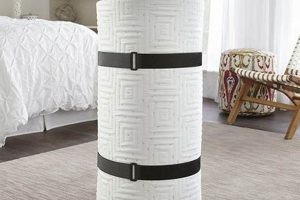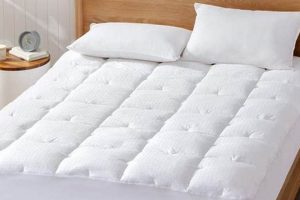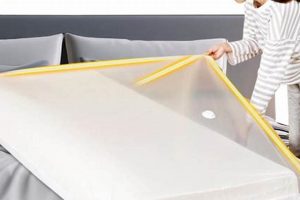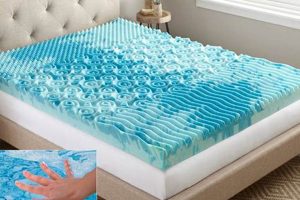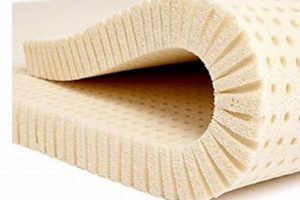A cushioning layer designed to be placed atop an existing recreational vehicle bed, it enhances comfort and provides additional support. These overlays are typically constructed from materials such as memory foam, latex, or down alternatives. For instance, a three-inch memory foam layer can significantly improve the sleeping experience in a travel trailer or motorhome.
The use of such an addition addresses a common issue within the mobile living space: subpar factory-installed mattresses. Benefits include improved sleep quality, pressure point relief, and temperature regulation. Historically, individuals often resorted to replacing entire mattresses, but the advent of this product offers a more cost-effective and practical solution, especially considering the non-standard bed sizes frequently found in RVs.
The selection of a suitable enhancement involves considering factors such as material composition, thickness, density, and size compatibility. Evaluating these elements is crucial to maximizing the advantages offered and ensuring a restful night’s sleep while traveling.
Selecting a Suitable RV Mattress Enhancement
Optimizing sleep comfort within a recreational vehicle necessitates careful consideration. The following guidelines assist in the selection process, ensuring compatibility and enhanced rest.
Tip 1: Assess Mattress Dimensions Accurately: Recreational vehicles often feature beds of unconventional sizes. Precise measurements of the existing mattress are paramount to ensure proper fit and prevent overhang or insufficient coverage.
Tip 2: Prioritize Material Density: Higher density materials, such as memory foam with a density of 4 pounds per cubic foot or greater, generally provide superior support and durability compared to lower density alternatives.
Tip 3: Consider Thickness Based on Comfort Needs: Thickness typically ranges from two to four inches. Individuals seeking substantial cushioning may opt for a thicker profile, while those preferring a firmer feel should consider a thinner option.
Tip 4: Evaluate Temperature Regulation Properties: Memory foam can retain heat. Infused gel or open-cell construction can mitigate this effect, promoting airflow and a cooler sleeping environment. Latex is naturally breathable.
Tip 5: Inquire About Certifications: Certifications such as CertiPUR-US ensure the product has been tested for harmful substances and meets standards for emissions, content, performance, and durability.
Tip 6: Research Compression and Recovery Rate: The ability of the enhancement to quickly regain its original shape after compression indicates its resilience and long-term performance.
Tip 7: Check for Non-Slip Features: A non-slip backing or straps can prevent shifting during travel, maintaining consistent comfort and preventing potential safety hazards.
Adhering to these guidelines when evaluating this product will increase the likelihood of selecting an option that effectively improves sleep quality and enhances the overall travel experience.
Careful selection contributes significantly to the satisfaction derived from mobile living.
1. Material Composition
The materials used in the construction significantly dictate its performance, comfort, and durability. Different materials offer varying levels of support, temperature regulation, and resistance to wear, all of which are crucial considerations for the confined and often fluctuating environment of an RV.
- Memory Foam: Viscoelastic Properties
Memory foam conforms to the body’s contours, distributing weight evenly and reducing pressure points. However, standard memory foam tends to retain heat. Manufacturers often infuse gel particles or utilize open-cell structures to improve airflow and mitigate heat build-up. The density of the foam determines its supportiveness and longevity; higher density foams generally last longer and provide greater support.
- Latex: Natural Resilience and Breathability
Latex, derived from rubber trees, offers a responsive and supportive surface. It is naturally breathable, promoting airflow and temperature regulation. Latex possesses inherent antimicrobial properties, which can be beneficial in the potentially humid environment of an RV. Two primary types exist: Dunlop and Talalay. Dunlop is denser and firmer, while Talalay is softer and more consistent.
- Down Alternative: Hypoallergenic Comfort
Down alternative fills, typically composed of synthetic fibers like polyester, provide a plush and hypoallergenic alternative to traditional down. These materials are often less expensive than memory foam or latex. However, they may compress more easily over time and offer less support. They are generally easier to clean and maintain than natural down.
- Support Foam: Foundation and Stability
Many options incorporate a base layer of high-density support foam. This layer provides foundational support and prevents the more conforming top layer from bottoming out. The type and density of the support foam influence the overall firmness and stability of the product.
The interplay of these materials dictates the suitability of the product for use in recreational vehicles. Careful consideration of material properties is essential to ensure optimal comfort, durability, and temperature regulation within the constraints of RV travel.
2. Thickness Variations
Thickness is a critical attribute that directly influences the perceived comfort and overall effectiveness of a mattress overlay. Measured in inches, this dimension significantly impacts pressure relief and support. A thinner overlay, generally ranging from one to two inches, primarily serves to add a slight degree of cushioning to an existing mattress. This configuration might be suitable for individuals seeking a subtle enhancement without drastically altering the bed’s feel. A thicker overlay, typically three to four inches, provides more substantial pressure relief and can significantly alter the feel of a firmer mattress, making it a more suitable option for those requiring enhanced cushioning or seeking to mitigate the effects of an aging or uncomfortable RV mattress. For example, an individual with back pain might find a three-inch memory foam overlay offers superior comfort compared to a thinner alternative.
The selection of appropriate thickness depends on factors such as the individual’s weight, sleeping position, and the condition of the existing mattress. A heavier individual may require a thicker overlay to prevent bottoming out, while a side sleeper may benefit from the enhanced pressure relief provided by a thicker profile. Furthermore, the space constraints within a recreational vehicle cabin necessitate careful consideration. Excessively thick overl
ays can elevate the sleeping surface to an uncomfortable or impractical height, potentially interfering with existing fixtures or headroom. The interplay between desired comfort level, individual physical characteristics, and the limitations of the RV’s interior dimensions dictates the optimal thickness for a given application.
Understanding the implications of thickness variations is paramount when selecting a mattress enhancement for RV use. The correct choice provides enhanced comfort and support. Balancing personal comfort preferences with the practical considerations of RV living is essential for achieving optimal results. Failure to properly assess thickness needs can result in dissatisfaction with the purchase and a failure to adequately address underlying sleep comfort issues.
3. Density Considerations
Density, measured in pounds per cubic foot (lbs/ft), is a critical factor influencing the performance, longevity, and overall comfort of a mattress overlay used in recreational vehicles. It directly impacts support, durability, and resistance to compression, all of which are crucial given the often-compact and variable conditions within an RV.
- Support and Pressure Relief
Higher density materials provide enhanced support, distributing weight more evenly and reducing pressure points. For example, a memory foam overlay with a density of 4 lbs/ft or higher will offer significantly better support than one with a density of 2 lbs/ft, mitigating discomfort and promoting proper spinal alignment during sleep. The former is more suitable for individuals experiencing back pain or requiring greater support.
- Durability and Longevity
Density is a primary indicator of durability. Lower density materials are more prone to compression and degradation over time, leading to a loss of support and comfort. A high-density overlay will maintain its structural integrity and supportive qualities for a longer period, representing a more cost-effective investment in the long run. Frequent RV travel exacerbates wear and tear, making density a particularly relevant consideration.
- Compression Resistance
The ability to resist compression is directly proportional to density. A high-density overlay will resist flattening under pressure, ensuring consistent support throughout the night. This is especially important for individuals sharing the sleeping space or for those who shift positions frequently during sleep. Low-density options tend to bottom out, negating their intended benefits.
- Temperature Regulation (Indirectly)
While not a direct determinant, density can indirectly influence temperature regulation. Higher density memory foam, in particular, tends to retain more heat due to its reduced airflow. Manufacturers often employ techniques such as gel infusions or open-cell structures to counteract this effect in high-density options, mitigating heat buildup and promoting a cooler sleeping environment.
The choice of density necessitates a balance between desired comfort and the practical considerations of RV use. Higher density options, while generally superior in terms of support and durability, may also command a higher price point. Careful assessment of individual needs and priorities is essential to selecting an appropriate product that optimizes sleep quality within the constraints of the recreational vehicle environment. The higher initial cost is weighed against the potential need for more frequent replacement, and ultimately a long-term investment in better rest while on the road.
4. Size Compatibility
Achieving optimal sleep comfort within a recreational vehicle necessitates precise size matching between the existing mattress and the accessory. Failure to adhere to dimensional accuracy compromises the intended benefits and can lead to discomfort or functional issues.
- Standard RV Bed Dimensions
Recreational vehicles often feature beds deviating from standard residential sizes. Common variations include short queen, RV king, and bunk bed dimensions. Purchasing a topper without verifying dimensions often results in overhang, insufficient coverage, or the need for modification. Inaccurate sizing negates the intended comfort enhancement and may present safety concerns.
- Accounting for Curved or Angled Mattresses
Some RV mattresses incorporate curved or angled edges to optimize space utilization within the vehicle’s interior. Standard rectangular toppers will not conform correctly to these shapes, leading to gaps, bunching, and uneven support. Custom-cut or specifically designed toppers are often necessary to accommodate these unique configurations, ensuring full surface coverage and uniform comfort distribution.
- Thickness Considerations Relative to Overhead Space
The addition of a topper increases the overall height of the sleeping surface. In confined RV spaces, this can impinge upon available headroom, particularly in bunk areas or over-cab sleeping platforms. Before purchase, assessing vertical clearance is crucial to prevent discomfort or restriction of movement. A thicker topper may provide greater comfort but potentially compromise usability in low-ceiling environments.
- Securement Methods and Size Alignment
Proper sizing facilitates the secure attachment of a topper to the existing mattress. Overhang or insufficient coverage can hinder the effective use of straps or elastic bands designed to prevent shifting during travel. Inadequate securement leads to uneven weight distribution, discomfort, and potential displacement of the topper during vehicle motion, undermining the purpose of the enhancement.
Addressing these dimensional considerations ensures the proper fit and function of a mattress overlay within the constraints of a recreational vehicle. Prioritizing size compatibility is paramount to maximizing comfort and achieving a restful sleep experience while traveling.
5. Temperature Regulation
Temperature regulation within a recreational vehicle sleeping environment is a critical factor influencing sleep quality. Mattress overlays significantly impact heat retention and dissipation. Certain materials, particularly traditional memory foam, possess inherent insulating properties that can lead to heat buildup and discomfort, especially in the often-confined and poorly ventilated spaces of RVs. Conversely, materials designed with enhanced breathability mitigate these effects. For instance, gel-infused memory foam or latex toppers promote airflow, reducing heat retention and contributing to a more comfortable sleeping temperature. The impact of material choice on temperature is amplified in warmer climates or during summer months when RV cooling systems may struggle to maintain optimal interior temperatures.
The effect of temperature regulation directly influences sleep quality and overall well-being during travel. Overheating disrupts sleep cycles, leading to restlessness, reduced sleep duration, and daytime fatigue. The selection of a mattress overlay with adequate temperature
regulation properties is therefore essential for ensuring a restful and restorative sleep experience. Real-world examples include RV owners who have reported significant improvements in sleep quality after switching from standard memory foam to latex or gel-infused toppers, especially in warmer regions. These individuals experienced fewer instances of night sweats and improved overall sleep comfort, leading to enhanced daytime alertness and enjoyment of their travels.
In summary, temperature regulation is a crucial consideration in the selection of a mattress overlay for RV use. The insulating properties of certain materials can exacerbate heat buildup, negatively impacting sleep quality. Conversely, materials with enhanced breathability promote airflow and contribute to a cooler, more comfortable sleeping environment. Prioritizing temperature regulation through informed material selection is essential for optimizing sleep quality and enhancing the overall travel experience in recreational vehicles.
Frequently Asked Questions About RV Mattress Overlays
This section addresses common inquiries regarding the selection, use, and maintenance of mattress overlays specifically designed for recreational vehicles.
Question 1: What materials are most suitable for RV mattress overlays, considering temperature fluctuations?
Latex and gel-infused memory foam are preferred due to their enhanced breathability and temperature regulation properties. Standard memory foam tends to retain heat, potentially leading to discomfort in warm environments.
Question 2: How does the density of an RV mattress overlay affect its performance?
Higher density materials offer greater support, durability, and resistance to compression. A density of 4 lbs/ft or higher is generally recommended for memory foam overlays intended for regular use.
Question 3: Are custom-sized RV mattress overlays necessary, or can standard sizes be adapted?
Custom sizes are often required due to the non-standard dimensions of many RV mattresses. Attempting to adapt standard sizes may result in improper fit, reduced comfort, and potential safety hazards.
Question 4: How can the shifting of an RV mattress overlay during travel be prevented?
Overlays with non-slip backings or integrated straps are recommended. These features secure the topper to the existing mattress, preventing movement and ensuring consistent support during vehicle motion.
Question 5: What certifications should be considered when purchasing an RV mattress overlay?
CertiPUR-US certification indicates that the product has been tested for harmful substances and meets standards for emissions, content, performance, and durability.
Question 6: How frequently should an RV mattress overlay be cleaned or replaced?
Regular cleaning, following the manufacturer’s instructions, is recommended. Replacement frequency depends on material quality, usage intensity, and signs of wear. A lifespan of 3-5 years is typical for high-quality overlays under normal usage conditions.
Selecting the correct overlay based on material, density, size, and certifications promotes improved sleep and maximizes the life of the product.
The following section details the practical considerations for integrating the mattress accessory within mobile living spaces.
Conclusion
The preceding exploration has detailed the salient factors concerning mattress toppers for RV use. Material composition, thickness variations, density considerations, size compatibility, and temperature regulation each contribute to the ultimate performance and user satisfaction. A comprehensive understanding of these elements empowers informed decision-making.
Optimal sleep within the constraints of mobile living directly impacts overall well-being and the enjoyment of travel. Therefore, investing in a suitable mattress topper represents a strategic decision, the benefits of which extend beyond mere comfort to encompass improved health and enhanced recreational experiences. Continued innovation in materials and design promises further refinement in the future.


